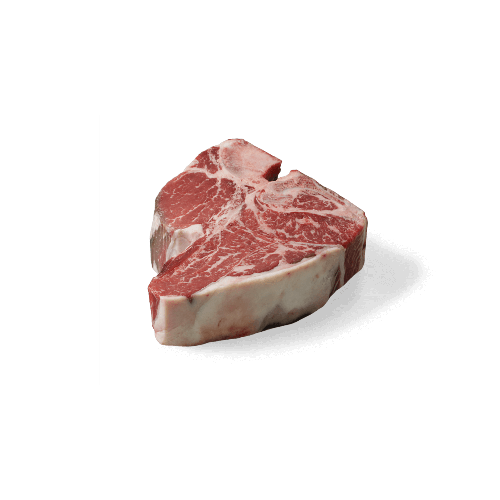 USDA PRIME
USDA PRIME
These Porterhouse Steaks are graded USDA Prime, the top tier of quality in the U.S. On average, about 9% of graded cattle will achieve Prime status, but taking things a step further, we inspect each primal that moves through our facility to guarantee quality. If we don’t think a piece deserves the Prime grade, we won’t ship it.
 HOLSTEIN CATTLE
HOLSTEIN CATTLE
Our Porterhouse Steaks are cut from Holstein cattle, raised in California predominantly in the Southeast corner of the state. The size (diameter) of Holstein steaks will be smaller than the Angus, which will allow for a thicker steak. If you are planning on cooking your Porterhouse Steaks “Fiorentina” Style (Standing the steak upright on the bone), you can achieve this trick with both our 32oz and 40oz cuts.
 SHIP FRESH
SHIP FRESH
We cut these Porterhouse steaks fresh the day we ship out, and once they are received they are good for 4-5 days in your refrigerator, or 6-7 months in the freezer.
 DRY AGED
DRY AGED
Before these were processed into steaks, the Shortloin primal that these Porterhouse Steaks were cut from was dry aged for 30-35 days.
The Porterhouse steak is cut from the large end of the shortloin. There are two separate steaks that combine to make this cut. The larger section is the New York Steak, and the smaller is the Filet Mignon. On an average shortloin, there are about 10-12 inches of what can be produced as a Porterhouse steak, so the desired thickness will determine the number of steaks per loin. The reason for this is that the Filet is not a uniform thickness from one end of the shortloin to the other — it tapers down to a vanishing point, and in order for the steak to be considered a Porterhouse steak, it has to have a decent-sized filet.
What happens to the rest of the shortloin when the filet is too small? This is where the T-bone steak is from; the only difference between the Porterhouse and the T-Bone is the size of the filet. We don’t generally cut the T-Bone for a couple of reasons (keep in mind that just because we don’t generally do it, there’s not much we won’t do if you say ‘pretty please’). Firstly because the ratio of bone to meat is unequal on the bone side of things, and we think that you can achieve the same cut with less bone by choosing the Kansas City Strip Steak. Secondly, the remainder of the Filet Mignon on a T-Bone steak is pretty much lost during the cooking; it’s so small and so tender that invariably it gets charred beyond recognition on the grill. What we prefer to do is remove the entire filet tail (that little tapering end of the filet) in one piece and treat it as its own special steak (the shortloin tail).
A famous variation on the Porterhouse steak is the Tuscan Bistecca Fiorentina, which has gained notoriety mainly because of the unique cooking method it allows. Generally, it is 2.5” to 3” thick (will serve 3-4) and is seared on both sides to give it a good dark look, then finished indirectly by standing it up on the grill with the bone as the base. What this does is allows the bone to act as a heat shield at the point of direct heat, while still allowing the high cooking temperature to indirectly surround the steak. And if you pull it off, you look like a pro at the grill, to boot. Go ahead, be a hero.
![]() USDA PRIME
USDA PRIME![]() SHIP FRESH
SHIP FRESH

